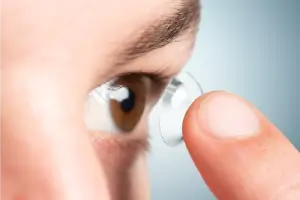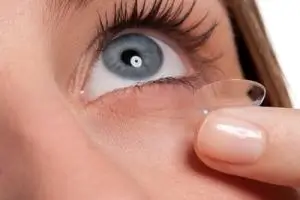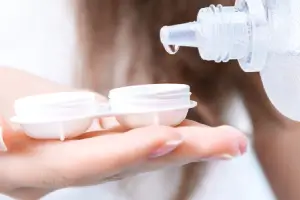





Thin, curved contact lenses are applied directly to the surface of the eye to treat visual issues or for aesthetic reasons. They are frequently used in place of eyeglasses. The most common kind of contact lens material is soft, flexible plastic, however rigid gas permeable (RGP) lenses are also available.
Astigmatism, Presbyopia, Hyperopia (farsightedness), and Myopia (nearsightedness) are examples of refractive defects that can be corrected using contact lenses by directly focusing light into the retina. Compared to glasses, they offer a greater field of vision and don't get in the way of activities like sports that might be difficult to accomplish while wearing glasses.

1.Soft Contact Lenses: These are the most prevalent kind and are composed of pliable, supple plastic. They are available in several alternatives, including daily disposable, bi-weekly, and monthly lenses, and are pleasant to use.
2.Rigid Gas Permeable (RGP) Contact Lenses: The material used to make these lenses stiffer, more oxygen can reach the cornea. Though they could need some getting used to, they provide crisper vision.
3.Extended Wear Contact Lenses: It is intended that these lenses be worn constantly, even while you sleep. They can be worn for lengthy periods of time or on a regular basis, but it's important to heed the advice of your eye care specialist for safe usage.
4.Toric Contact Lenses: Toric lenses, which are specifically made for astigmatic, contain varying powers in different lens meridians to correct for the uneven curvature of the cornea.
5.Multifocal Contact Lenses: People can see clearly at different distances thanks to these glasses, which have varied prescriptions in different zones. Presbyopia is an age-related disorder that affects near vision, and they are frequently used to treat it.
To guarantee comfort and preserve eye health, using contact lenses requires a meticulous and hygienic procedure. Keep in mind that maintaining good cleanliness and following your eye care provider's instructions are essential for secure and pleasant contact lens usage. Seek advice from your eye care specialist if you have any questions or issues.

1 Wash your hands
Wash your hands thoroughly with soap and water first. To prevent lint or other debris from getting onto the lenses, dry them with a towel free of lint.

2 Prepare your work area
Select a spotless, level, and well-lit surface to work on. Ascertain that you have your contact lens case, a mirror, and any necessary solutions close at hand.

3 Check your lenses
Check your contact lenses for debris or damage. Do not use them if they are ripped or damaged.

4 Clean your lenses
To get rid of any remaining cleaning or storage solution, rinse your lenses with the suggested solution. Using your fingers, gently rub the lenses if your eye care expert recommends it.

5 Inserting the lenses
Using the tip of your index finger, place the lens there. Pull down your lower eyelid with your middle finger and hold open your top eyelid with your other hand. With your back to the mirror, carefully insert the lens in the middle of your eye. To make sure the lens is in the right place, blink a few times.

6 Removing the lenses
Make sure your hands are dry and clean before handling your lenses. Lift your gaze upwards and grasp your top eyelid with one hand while holding down your lower eyelid with the other. Pinch the lens lightly with your thumb and index finger, then take it out.

7 Cleaning and storing
As advised by your eye care expert, clean your lenses. If necessary, use the proper solution and give the lenses a rub. Keep the lenses in a case that is spotless and full of new solution. Make sure the casing is maintained clean and changed on a regular basis and change the solution every day.

8 Follow your eye care professional's advice
Always adhere to the detailed instructions supplied by the lens maker or your eye care specialist. Make sure your contact lenses are appropriate for your needs and that your eyes are healthy by scheduling routine examinations.
Additional Tips
Avoid using water, saliva, or homemade solutions to clean your lenses.
Never swap lenses with others, as this can lead to eye infections.
If you experience discomfort, redness, or irritation, remove the lenses, and consult your eye care professional.